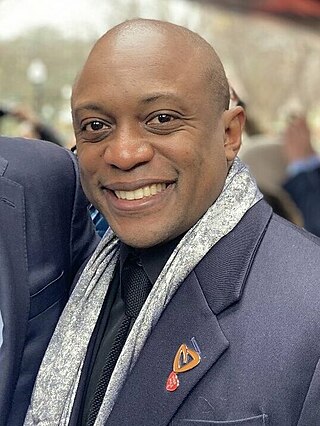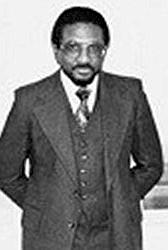
Hale Aspacio Woodruff was an American artist known for his murals, paintings, and prints.

Charles Wilbert White, Jr. was an American artist known for his chronicling of African American related subjects in paintings, drawings, lithographs, and murals. White's lifelong commitment—to chronicling the triumphs and struggles of his community in representational form—cemented him as one of the most well-known artists in African American art history. Following his death in 1979, White's work has been included in the permanent collections of the Art Institute of Chicago, Los Angeles County Museum of Art, The Metropolitan Museum of Art, the Whitney Museum of American Art, the National Gallery of Art, The Newark Museum, and the Santa Barbara Museum of Art. White's best known work is The Contribution of the Negro to American Democracy, a mural at Hampton University. In 2018, the centenary year of his birth, the first major retrospective exhibition of his work was organized by the Art Institute of Chicago and the Museum of Modern Art.

Thelma Beatrice Johnson Streat (1912–1959) was an African-American artist, dancer, and educator. She gained prominence in the 1940s for her art, performance and work to foster intercultural understanding and appreciation.
Visual arts of Chicago refers to paintings, prints, illustrations, textile art, sculpture, ceramics and other visual artworks produced in Chicago or by people with a connection to Chicago. Since World War II, Chicago visual art has had a strong individualistic streak, little influenced by outside fashions. "One of the unique characteristics of Chicago," said Pennsylvania Academy of Fine Arts curator Bob Cozzolino, "is there's always been a very pronounced effort to not be derivative, to not follow the status quo." The Chicago art world has been described as having "a stubborn sense ... of tolerant pluralism." However, Chicago's art scene is "critically neglected." Critic Andrew Patner has said, "Chicago's commitment to figurative painting, dating back to the post-War period, has often put it at odds with New York critics and dealers." It is argued that Chicago art is rarely found in Chicago museums; some of the most remarkable Chicago artworks are found in other cities.

Hank Willis Thomas is an American conceptual artist. Based in Brooklyn, New York, he works primarily with themes related to identity, history, and popular culture.
Wadsworth Aikens Jarrell is an American painter, sculptor and printmaker. He was born in Albany, Georgia, and moved to Chicago, Illinois, where he attended the Art Institute of Chicago. After graduation, he became heavily involved in the local art scene and through his early work he explored the working life of African-Americans in Chicago and found influence in the sights and sounds of jazz music. In the late 1960s he opened WJ Studio and Gallery, where he, along with his wife, Jae, hosted regional artists and musicians.
AfriCOBRA is an African-American artists' collective formed in Chicago in 1968. The group was founded by Jeff Donaldson, Wadsworth Jarrell, Jae Jarrell, Barbara Jones-Hogu, Nelson Stevens, and Gerald Williams.
The Organization of Black American Culture (OBA-C) was conceived during the era of the Civil Rights Movement by Hoyt W. Fuller as a collective of African-American writers, artists, historians, educators, intellectuals, community activists, and others. The group was originally known as Committee for the Arts (CFA), which formed in February 1967 in Southside Chicago, Illinois. By May 1967, the group became OBAC and included Black intellectuals Hoyt W. Fuller, the poet Conrad Kent Rivers, and Gerald McWorter. OBAC aimed to coordinate artistic support in the struggle for freedom, justice and equality of opportunity for African Americans. The organization had workshops for visual arts, drama, and writing, and produced two publications: a newsletter, Cumbaya, and the magazine Nommo.
Martha Jackson Jarvis is an American artist known for her mixed-media installations that explore aspects of African, African American, and Native American spirituality, ecological concerns, and the role of women in preserving indigenous cultures. Her installations are composed using a variety of natural materials including terracotta, sand, copper, recycled stone, glass, wood and coal. Her sculptures and installations are often site-specific, designed to interact with their surroundings and create a sense of place. Her works often focus on the history and culture of African Americans in the southern United States. In her exhibition at the Corcoran, Jarvis featured over 100 big collard green leaves, numerous carp and a live Potomac catfish.

Jefferson Pinder is an African-American performance artist whose work provokes commentary about race and struggle.
Calvin Bell Jones was an afrocentric visual artist and a Black Arts Movement activist from Chicago. He is known primarily for his nine murals and paintings.
Nina Chanel Abney is an American artist, based in New York. She was born in Harvey, Illinois. She is an African American contemporary artist and painter who explores race, gender, pop culture, homophobia, and politics in her work.

Elaine "Jae" Jarrell is an American artist best known for her fashion designs and her involvement with the Black Arts Movement of the 1960s.
Gerald Williams is an American visual artist whose work has been influential within the Black Arts Movement, a transnational aesthetic phenomenon that first manifested in the 1960s and continues to evolve today. Williams was a founding member of AfriCOBRA. His work has been featured in exhibitions at some of the most important museums in the world, including the Tate Modern, the Museum of Contemporary Art, Chicago, the Studio Museum in Harlem, and the Institute of Contemporary Art, Philadelphia. In addition to his influence as a contemporary artist, he has served in the Peace Corps, taught in the public schools systems of Chicago and Washington, D.C., and served as an Arts and Crafts Center Director for the United States Air Force. In 2015, he moved back to his childhood neighborhood of Woodlawn, Chicago, where he currently lives and works. In 2019, Mr. Williams was awarded The Honorary Doctors of Philosophy in Art by the School of the Art Institute of Chicago, along with his co-founders of the AFRICOBRA, Jae Jarrell, and Wadsworth A. Jarrell.
Barbara Jones-Hogu was an African-American artist best known for her work with the Organization of Black American Culture (OBAC) and for co-founding the artists' collective AfriCOBRA.
Dewey Crumpler, is an American painter and educator. He was an associate professor at the San Francisco Art Institute.
Napoleon Jones-Henderson is a Black American weaver and multimedia artist most known for his role in AfriCOBRA, an artist collective established in Chicago, Illinois, in 1968. Jones-Henderson joined AfriCOBRA in 1969, a year after its founding.
Billy Abernathy (1939–2016) was an American photographer. He was married to Laini (Sylvia) Abernathy, an artist and activist.
Parish Gallery was a Washington, DC art gallery located in the Georgetown neighborhood of Washington. It was active from 1991 to 2013.
Nelson Stevens was an artist known for his involvement with Chicago-based Black art collective AfriCOBRA. Stevens' works are held by institutions such as the Art Institute of Chicago, the Brooklyn Museum, Memphis Brooks Museum of Art, Pennsylvania Academy of the Fine Arts, the Smithsonian National Museum of African American History and Culture, and the Tate.






